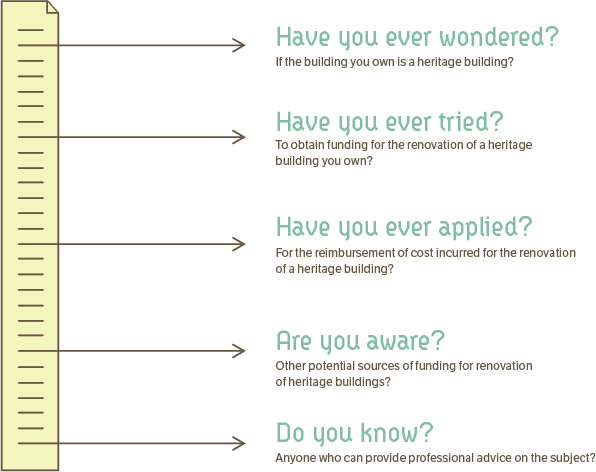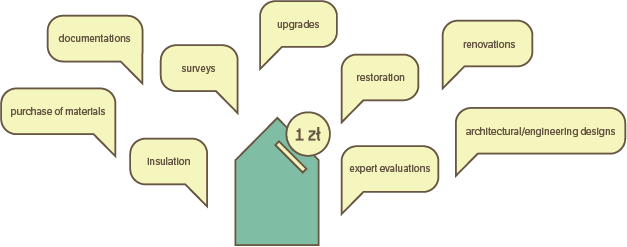


Why the fuss?
We often see buildings which in our opinion are of heritage value and are pleased and proud to see that they are refurbished and well maintained. If, on the other hand, they are dilapidated and uncared for, we tend to wonder why this is the case.
The condition of Katowice's heritage buildings is by no means a coincidence.
The heritage architecture protection and preservation system is partly responsible for this situation. Its functioning is illustrated by infographics which were developed based on relevant statistical data and show the formation of the register of heritage buildings, its structure and one of the sources for funding refurbishment projects of heritage buildings.
The buildings included in the register are not the only ones that are looked after. Other protected sites include those listed in municipal records of heritage sites, cultural heritage parks, historical monuments and special interest sites included local spatial development plans. The present infographics, however, apply to listed buildings only.


When does a building become a heritage building?
The first Katowice building was entered in the register of heritage buildings in the 1940s. In the following decades, conservation officers took interest in different buildings and gradually registered them for protection. Over time, younger and younger buildings were recognised as worthy of protection. In Katowice, the time between erection and registration of a building averages at 91 years.



And what about Katowice's Register of Heritage Buildings?
Building erection vs. building registration
The following diagram can traces the types of buildings which were registered by
conservation officers in recent decades to identify trends prevalent in different periods.
conservation officers in recent decades to identify trends prevalent in different periods.







Katowice's registered heritage buildings vs. grants
The contemporary register of heritage buildings the result of work carried out by several generations of conservation officers, whose efforts led to the protection of 304 heritage sites in Katowice. The diagram illustrates the disparity between the number of religious and non-religious heritage sites registered in Katowice.Its second part indicates an imbalance in the allocation of grants - less numerous religious buildings receive more funding.
The demand for grants, as estimated by the applicants, however, is much greater than the amounts paid.





A little more on grants | What may grant funds be allocated for?





Where to find more info?
Voivodship Heritage Conservation Officer
Voivodship Heritage Conservation Office
ul. Francuska 12, 40-015 Katowice, (32) 253 77 98
wkz.katowice.pl / swkz@wkz.katowice.pl
Voivodship Heritage Conservation Office
ul. Francuska 12, 40-015 Katowice, (32) 253 77 98
wkz.katowice.pl / swkz@wkz.katowice.pl
Silesian Cultural Heritage Centre
ul. Ligonia 7, 40-036 Katowice, (32) 251 71 04
scdk.pl / poczta@scdk.pl
ul. Ligonia 7, 40-036 Katowice, (32) 251 71 04
scdk.pl / poczta@scdk.pl
Ministry of Culture and National Heritage
Monuments Preservation Department
ul. Ksawerów 13, 02-656 Warszawa
(22) 848 10 48 / (22) 848 13 19/ (22) 646 05 27
mkidn.gov.pl
Monuments Preservation Department
ul. Ksawerów 13, 02-656 Warszawa
(22) 848 10 48 / (22) 848 13 19/ (22) 646 05 27
mkidn.gov.pl
Act on Heritage Protection and Safeguarding of 23 July 2003. The diagram shows examples of purposes for which funding can be used. Data on registered sites comes from the citizens' catalogue "Otwarte Zabytki" (Open Heritage Sights): (www.otwartezabytki.pl). Data on subsidies and refunds provided by the Voivodeship Heritage Conservation Officer comes from the reports by the Voivodeship Heritage Conservation Office, published between 2006-2011. The data is available on the Conservation Officer's website (www.wkz.katowice.pl)
Assumptions underlying data visualization:
• omission of sites registered as urban units/complexes (while taking into account their component)
• the omission of sites with unknown erection date
• rounding up site ages to full decades
• omission of sites registered as urban units/complexes (while taking into account their component)
• the omission of sites with unknown erection date
• rounding up site ages to full decades


